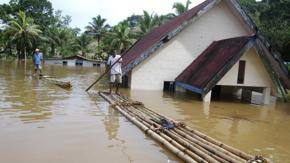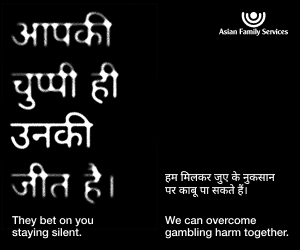Fiji Endures Another Watery Devastation

Just as Fiji was beginning to pick up the pieces and move on after the severe flooding that inundated large swathes of the country in January, it has been hit by wild weather conditions that have caused even worse flooding this past week.
Like everywhere else in the world, Fiji’s urban centres have grown around rivers and the incessant torrential rains over the past several days have caused almost all of these rivers to breach their banks and inundate entire towns.
I was in Suva after having attended a conference in Pacific Harbour, which is where I heard about the series of fronts approaching Fiji from the west-southwest direction. The domestic flight to Nadi took off six hours late from Nausori and it was when it came in to land that I got a sense of how bad the situation was and how worse it could get.
I could clearly see parts of the Queens Road submerged with cars stranded on the dry stretches unable to drive forward or return. The Nadi Back Road was also similarly submerged intermittently. Through the rain splattering fiercely on my window I could see Nadi streets turned into rivers, with just the roofs sticking out of the muddied, red-brown water. Namaka was more like a lake with its biggest building, the Colonial Plaza complex rapidly sinking under the rapidly rising waters.
Chaos at hotels, airport
My flight to Auckland was scheduled for the next day and it was impossible to find a room in the vicinity of the airport. Everything from Tokatoka, Raffles, Tanoa down the strip across Namaka and Martintar were chock-a-block full or had closed because of inundation. Much of Martintar resembled a lake.
I was lucky to find a place at a resort in Votualevu, which promptly ran out of water. With taps gone dry, there was water enough only for cooking, the manager said. News reports on radio described how people were stranded on rooftops all over the country’s western division, in some cases for 8 hours. Tourists were being evacuated from the luxury resorts from Denarau through to the Coral Coast by helicopter at exorbitant prices. The approach to the bridge on Queens Road just outside Nadi town had been swept away and was unusable for regular cars. Even the gruntiest of 4X4s would have found it a challenge to negotiate past the muck on to the bridge.
By Sunday morning there were reports of two deaths and a few people missing. The government opened evacuation centres all along the western division (more than 90 of them sheltering over 10,000 people). The situation was getting even worse as second front closely followed the first dumping even more rain.
The intensity of the rain had to be seen to be believed. It was like a wall of water at the base of a fast flowing waterfall, with no visibility more than ten feet away. And it rained like that for hours on end. No stormwater drainage system in the world could have handled that kind of rain in such short a time.
Several friends who live in Nadi and even as far as Sigatoka told me they had already evacuated or were in the process of evacuating from their homes into hotels, if available, or simply into evacuation centres on higher ground. As the government declared a state of emergency, services all the way from Sigatoka to Rakiraki, were stretched to their capacity, with both the police and the armed forces working side by side in rescue and relief operations.
Long wait at airport
Air Pacific and Air New Zealand announced the cancellation of all international flights in and out of Fiji on Saturday afternoon and there was no information about when flights would resume. Nadi International Airport was overflowing with people and their baggage, with many forced to sleep at the terminal for as many as three nights in a row.
As passengers waited long hours patiently for any updates from the airlines, the live coverage of the Tokyo Sevens matches provided welcome relief to both visitors and locals, who cheered every time a Fijian player scored a try. The locals were downcast when Samoa beat Fiji 24-21 in the quarters.
Waiting passengers exchanged tales of horror of the watery devastation they had endured. One elderly man who had come in to see his daughter off said it had taken them nine hours to reach Nadi from Ba, which they had left early when they saw the flood waters swirling in.
Another couple said they walked 5km from a point between Nadi and Lautoka, when their taxi was stranded in water, before they were picked up by a passing truck and dropped at the airport. Parts of their trek had been through waist deep water. The man said he had to throw out his shoes and a set of clothes because they were so dirty, they could not be packed into his suitcase.
Stranded tourists were not only from New Zealand and Australia but even as further afield as Norway, Canada, the US and Europe. While most were patient and understanding of the situation, some were disappointed and complained about transporters’ price gouging because of the situation. Taxis charged three times the normal fare and the prices of food and bottled water more than doubled.
Tourists travelling with small children were huddled in the terminal’s corners as well as in the middle of check in queues that had not moved even an inch for hours on end. While parents went online to check the latest updates, the children played with toys, mobile phones and handheld devices until the batteries lasted.
Employees at the airports cafes said they hadn’t been home in three days because of the continuous flow of customers (some said they simply couldn’t go home because the roads were underwater). The cafes served customers round the clock.
Disease warnings
Meanwhile, the government issued warnings of disease outbreaks and against drinking water contaminated by the floods. Water supply to several areas in Nadi and the resorts had been cut off and so was the power supply as a precautionary measure. In some areas, power lines were dipping into the flooding waters and the Fiji Electricity Authority (FEA) asked all fallen wires to be treated as live.
Late on Sunday, after repeatedly announcing that all flights were cancelled and many passengers had either left the terminal or had dozed of to sleep on the floor, Air Pacific suddenly said that it had made available a Boeing 747 bound for Auckland that would take all its own passengers as well as those of Air New Zealand.
Lusty clapping and loud cheers from passengers – some of who were stranded for more than 48 hours – accompanied the take off of the flight as it winged its way to Auckland.
Just as Fiji was beginning to pick up the pieces and move on after the severe flooding that inundated large swathes of the country in January, it has been hit by wild weather conditions that have caused even worse flooding this past week. Like everywhere else in the world, Fiji’s urban centres...
Just as Fiji was beginning to pick up the pieces and move on after the severe flooding that inundated large swathes of the country in January, it has been hit by wild weather conditions that have caused even worse flooding this past week.
Like everywhere else in the world, Fiji’s urban centres have grown around rivers and the incessant torrential rains over the past several days have caused almost all of these rivers to breach their banks and inundate entire towns.
I was in Suva after having attended a conference in Pacific Harbour, which is where I heard about the series of fronts approaching Fiji from the west-southwest direction. The domestic flight to Nadi took off six hours late from Nausori and it was when it came in to land that I got a sense of how bad the situation was and how worse it could get.
I could clearly see parts of the Queens Road submerged with cars stranded on the dry stretches unable to drive forward or return. The Nadi Back Road was also similarly submerged intermittently. Through the rain splattering fiercely on my window I could see Nadi streets turned into rivers, with just the roofs sticking out of the muddied, red-brown water. Namaka was more like a lake with its biggest building, the Colonial Plaza complex rapidly sinking under the rapidly rising waters.
Chaos at hotels, airport
My flight to Auckland was scheduled for the next day and it was impossible to find a room in the vicinity of the airport. Everything from Tokatoka, Raffles, Tanoa down the strip across Namaka and Martintar were chock-a-block full or had closed because of inundation. Much of Martintar resembled a lake.
I was lucky to find a place at a resort in Votualevu, which promptly ran out of water. With taps gone dry, there was water enough only for cooking, the manager said. News reports on radio described how people were stranded on rooftops all over the country’s western division, in some cases for 8 hours. Tourists were being evacuated from the luxury resorts from Denarau through to the Coral Coast by helicopter at exorbitant prices. The approach to the bridge on Queens Road just outside Nadi town had been swept away and was unusable for regular cars. Even the gruntiest of 4X4s would have found it a challenge to negotiate past the muck on to the bridge.
By Sunday morning there were reports of two deaths and a few people missing. The government opened evacuation centres all along the western division (more than 90 of them sheltering over 10,000 people). The situation was getting even worse as second front closely followed the first dumping even more rain.
The intensity of the rain had to be seen to be believed. It was like a wall of water at the base of a fast flowing waterfall, with no visibility more than ten feet away. And it rained like that for hours on end. No stormwater drainage system in the world could have handled that kind of rain in such short a time.
Several friends who live in Nadi and even as far as Sigatoka told me they had already evacuated or were in the process of evacuating from their homes into hotels, if available, or simply into evacuation centres on higher ground. As the government declared a state of emergency, services all the way from Sigatoka to Rakiraki, were stretched to their capacity, with both the police and the armed forces working side by side in rescue and relief operations.
Long wait at airport
Air Pacific and Air New Zealand announced the cancellation of all international flights in and out of Fiji on Saturday afternoon and there was no information about when flights would resume. Nadi International Airport was overflowing with people and their baggage, with many forced to sleep at the terminal for as many as three nights in a row.
As passengers waited long hours patiently for any updates from the airlines, the live coverage of the Tokyo Sevens matches provided welcome relief to both visitors and locals, who cheered every time a Fijian player scored a try. The locals were downcast when Samoa beat Fiji 24-21 in the quarters.
Waiting passengers exchanged tales of horror of the watery devastation they had endured. One elderly man who had come in to see his daughter off said it had taken them nine hours to reach Nadi from Ba, which they had left early when they saw the flood waters swirling in.
Another couple said they walked 5km from a point between Nadi and Lautoka, when their taxi was stranded in water, before they were picked up by a passing truck and dropped at the airport. Parts of their trek had been through waist deep water. The man said he had to throw out his shoes and a set of clothes because they were so dirty, they could not be packed into his suitcase.
Stranded tourists were not only from New Zealand and Australia but even as further afield as Norway, Canada, the US and Europe. While most were patient and understanding of the situation, some were disappointed and complained about transporters’ price gouging because of the situation. Taxis charged three times the normal fare and the prices of food and bottled water more than doubled.
Tourists travelling with small children were huddled in the terminal’s corners as well as in the middle of check in queues that had not moved even an inch for hours on end. While parents went online to check the latest updates, the children played with toys, mobile phones and handheld devices until the batteries lasted.
Employees at the airports cafes said they hadn’t been home in three days because of the continuous flow of customers (some said they simply couldn’t go home because the roads were underwater). The cafes served customers round the clock.
Disease warnings
Meanwhile, the government issued warnings of disease outbreaks and against drinking water contaminated by the floods. Water supply to several areas in Nadi and the resorts had been cut off and so was the power supply as a precautionary measure. In some areas, power lines were dipping into the flooding waters and the Fiji Electricity Authority (FEA) asked all fallen wires to be treated as live.
Late on Sunday, after repeatedly announcing that all flights were cancelled and many passengers had either left the terminal or had dozed of to sleep on the floor, Air Pacific suddenly said that it had made available a Boeing 747 bound for Auckland that would take all its own passengers as well as those of Air New Zealand.
Lusty clapping and loud cheers from passengers – some of who were stranded for more than 48 hours – accompanied the take off of the flight as it winged its way to Auckland.









Leave a Comment